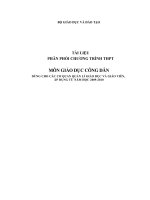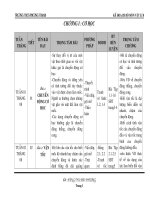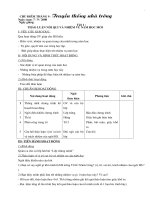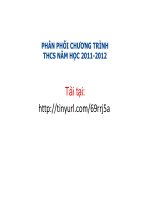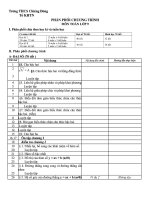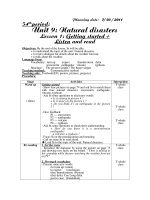Unit 9 ( theo phan phoi chuong trinh moi )
Bạn đang xem bản rút gọn của tài liệu. Xem và tải ngay bản đầy đủ của tài liệu tại đây (131.16 KB, 9 trang )
Planning date: 7/ 03 / 2011
54
th
period:
Unit 9: Natural disasters
Lesson 1: Getting started +
Listen and read
Objectives: By the end of the lesson, Ss will be able:
+ to understand the topic of the unit: Natural disasters.
+ to read a dialogue for details about the weather forecast.
+ to talk about the weather.
Language focus:
Vocabulary: turn up expect thunderstorm delta
snowstorm earthquake volcano typhoon
Structure: The present simple / The future simple
Teaching method: Communicative method
Teaching aids: Textbook(E9), posters, pictures, projector
Procedure:
Stage Activities Interaction
Warm up
(10ms)
Getting started
- Show four pictures on page 74 and ask Ss to match them
with four natural disasters: snowstorm, earthquake,
volcano, typhoon.
- Ask Ss some questions to elicit new words:
+ Is it raining in picture 4 ?
+ Is it snowy in the picture 1 ?
+ Do you think it s an earthquake in the picture’
2 ?
……
- Give feedback:
P1 – snowstorm
P2 – earthquake
P3 – volcano
P4 – typhoon
- Ask Ss some questions to check their understanding.
+ How do you know it is a snowstorm/an
earthquake/
a volcano/ a typhoon ?
- Focus Ss on the pronunciation and meaning.
- Call on some Ss to read aloud.
Lead Ss to the topic of the unit: Natural disasters.
T-whole
class
T-whole
class
T-whole
class
Re-reading 1. Set the scene
- Introduce the dialogue by using the picture on page 75
and drawing two faces on the board. “ Thuy is talking to
her grandma while theyare watching the weather forecast
on TV”
2. Pre-teach vocabulary
- Present some new words:
(to) turn up: (mine)
to expect: (ranslation)
(the) thunderstorm: (Picture)
(the) delta: Cuu Long delta
just in case: (translation)
T-whole
class
T-whole
class
(10ms)
- Focus Ss on the pronunciation and meaning.
- Call on some Ss to read aloud.
Checking: Rub out and remember
3. T/F prediction
- Have Ss to guess about the dialogue.
1. There won t be any sunshine in Ha Noi. ’
2. Temperature in Hue will be over 30
o
C.
3. It will be cloudy in Cuu Long Delta.
4. Thuy is going out for a picnic with her old
friends.
5. Thuy s grandmother asks her to bring along’
a warm coat.
6. Thuy follows her grandmother s advice. ’
- Give feedback.
T-whole
class
While-
reading
(10ms)
1. Prediction check
- Ask Ss to listen and read the text, then ckeck their
predictions.
- Have Ss listen to the dialogue twice.
- Get the answer from Ss.
- Give feedback: 1.F 2.F 3.T 4.T 5.F 6.T
2. Rolw adoption
- Ask Ss to practice the dialogue in groups of three.
- Call on some groups to practice in front of the class.
- Focus Ss on the pronunciation and intonation.
3. Gap-fill
- Ask Ss to read the dialogue again and complete the
sentences on page 75,76.
- Get the answer from Ss.
- Feedback and correction: (Answer key: Teacher’s
book/P.98)
Individual
work
Pairwork
Individual
work
Post-reading
(11ms)
Speaking
- Ask Ss to read again the weather forecast on TV and
notice some phrases:
+ … will have temperature between … and …
+ … will experience temperature between … and
….
+ HCM…s temperature will be between … and ….
+ … can expect clouds / thunderstorms……
- Ask Ss to look at the map on page 75 and play the role of
the weatherman to present the weather forecast, based on
the information given.
- Call on some Ss to present before the class.
- Feedback and correction.
T-whole
class
Pairwork
Ss-whole
class
Consolidatio
n
(2ms)
- Focus on what Ss have learned. T-whole
class
Homework
(2ms)
- Ask Ss to write a weather forecast. The dialogue will
help them. Ss can change the information, the places,…
Planning date: 22 / 03 / 2011
55
th
period:
Unit 9: Natural disasters
Lesson 2: Speak + Language 1,2
Objectives: By the end of the lesson, Ss will be able:
+ to talk about what they want to buy and do to prepare for a typhoon.
+ to use relative clause
Language focus:
Vocabulary: block roller bucket leak tie latch ladder blanket available
Structure: The present simple / The future simple / the passive form.
Teaching method: Communicative method
Teaching aids: Textbook(E9), posters, pictures, projector
Procedure:
Stage Activities Interaction
Warm up
(5ms)
1. Shark’s attrack
- Have Ss play the game:
EARTHQUAKE
2. Chatting
- Ask Ss some questions about earthquake:
+ Have you ever heard of an earthquake ?
+ What happens if there is an earthquake ?
+ In which countries do earthquakes often
occur ?
Lead Ss to the topic of the lesson.
T-whole
class
T-whole
class
Pre-speaking
(10ms)
1. Set the scene:
We have heard a talk on how to live with the earthquakes.
Now we are talking about how to prepare for a typhoon.
2. Pre-teach vocabulary
- Present some new words:
bucket (n): (realia)
leak (n): (picture)
tie (v): (mime)
latch (n): (realia)
ladder (n): drawing)
blanket (n): (picture)
available(a): (translation)
- Focus Ss on the pronunciation and meaning.
- Call on some Ss to read aloud.
Checking: Rub out and remember
3. Brainstorming
- Have Ss think about what they do to prepare for a
typhoon.
(Speak a – P.76)
- Get Ss’ answer and lay them out on the board.
+ Buying some caaned food.
+ Buying candles and matches.
+ Filling all buckets with water.
+ Fixing the leak in the roof.
+ Tying the roof to the ground with pegs and
ropes.
+ Checking all the window and door latches.
- Elicit some questions and get Ss to ask and answer in
pairs.
(Ss look at the orange table on page 76)
+ Why do we need to buy food ?
Because the market will be closed and no food will be
available.
+ Why do we need to buy candles and matches ?
T-whole
class
T-whole
class
T-whole
class
T-whole
class
T-whole
class
Because there may be power cut.
…………
4. Language use
- Ask Ss to use the expressions when talking to one
another.
+ I think …
+ I think you should….
+ Yes. I think so.
+ What for ? /Why? Because…
While-
speaking
(8ms)
Word Cue Drill
- Ask Ss to talk about what they think they want to buy
and do to prepare for a typhoon; explain why. The ideas in
the bubbles on page 77 can help Ss talk easier.
Example exchange:
S
1
: I think we should buy some canned food
before a typhoon.
S
2
: Yes. I think so. Because the market will be
closed
and no food will be available.
S
1
: I think we should buy a ladder
S
2
: What for ?
S
1
: Just in case we need to fix the roof. Because
there must be strong wind blowing
- Call on some pairs to practice in front of the class.
Pairwork
Post speaking
20ms
1. Relative pronouns
- Ask Ss to answer the questions in Language focus 1
using the relative pronouns: who, that, which.
Example:
a. The city which was struck by a huge earthquake in
1995 in Japan is Kobe.
- Get the answer from Ss.
- Give feedback: (Answer key: Teacher’s book/P.103)
- Ask ss to review the use of the relative pronouns
Relative pronouns ( who, which, that) are used to replace
the pronoun.
Who is used for people
Which is used for things.
That is used for both people and things
2. Relative clauses
- Ask Ss to review the differences between Defining and
Non-defining.
Defining: Support important and necessary information
for the meaning of the sentences.
Example:
Auld Lang Syne is a song which is sung on New Year s’
Eve.
Non-defining: Support extra information for the meaning
of the sentences. The beginning and the end of the Non-
defining has commas.
Example:
My friend Tom, who sings Western songs very well, can
compose songs.
* That is only used in Defining
- Ask Ss to do Language focus 3/P.82. They have to
underline the relative clause. Then add commas to
separate the non-defining relative clause from the rest of
the sentence.
Pairwork
T-whole
class
T-whole
class
Individual
work
- Get the answer from Ss.
- Give feedback: (Answer key: Teacher’s book/P.105)
Matching (Language focus 2)
- Ask Ss to read the sentences in column A and B
carefully.
- Focus Ss on the meaning of the sentences.
- Ask Ss to match each of the sentences in column A with
the a related sentence in column B.
- Give feedback: (Answer key: Teacher’s book/P.104)
- Ask Ss to use a suitable relative pronoun to join the two
sentences (Using the non-defining relative clause)
Example:
1. Andrew is flying to Sacramento.
e. Sacramento is the capital city of California.
Andrew is flying to Sacramento, which is the capital
city of California.
- Give feedback: (Answer key: Teacher’s book/P.104)
T-whole
class
Pairwork
Individual
work
Consolidatio
n
(2ms)
- Focus on what Ss have learned T-whole
class
Homework
(1ms)
- Ask Ss to write something about what they have to do to
prepare for a typhoon.
Planning date: 24 / 03/ 2011
56
th
period:
Unit 9: Natural disasters
Lesson 3: Listen + Language 3,4
Objectives: By the end of the lesson, Ss will be able:
+ to talk about what they want to buy and do to prepare for a typhoon.
+ to listen for details about how to live with earthquakes.
Language focus:
Vocabulary: block roller bucket leak tie latch ladder blanket available
Structure: The present simple / The future simple / the passive form.
Teaching method: Communicative method
Teaching aids: Textbook(E9), posters, pictures, projector
Procedure:
Stage Activities Interaction
Warm up
(7ms)
Let sts see watch some picture or video of earthquake
Question and answer
1. Do you know anything about earthquakes ?
2. Are they dangerous ?
3. Are there many earthquakes in VietNam ?
4. In which countries do earthquakes usually occur ?
5. What would you do if an earthquake occurred ?
( Before , while and after the earth quake )
Lead Ss to the topic of the lesson.
T-whole
class
Pre-listening
(7ms)
1. Set the scene
- Introduce the text by using the table on page 77 and
saying: An expert is giving a talk on how to live with“
earthquakes block , roller ” ”
2. Gap-fill prediction
- Ask Ss to look at the table on page 77 and guess the
missing words in the blanks from (1) to (9).(present some
new words:
- Give feedback
T-whole
class
T-whole
class
While-
Listening
(6ms)
Prediction check
- Have Ss to listen to the tape twice and check their
predictions.
- Get the answer from Ss.
- Give feedback: Answer key
1. bottom shelf of the bookshelf. 2. fridge
3. washing machine 4. mirrors
5. a window 6. inside
7. under a strong table. 8. doorway
9. corner of a room
Individual
work
T-whole
class
Post
listenimg
(20ms)
1- Write it -up
- Work in group and make a short presentation on how to
live with earthquakes based on the information in the
table .
- Call on some Ss present in front of class.
- Comment and make corrections if necessary .
2-Relative clause
Ask sts to remember how to use relative clause
(last previous)
.Task 3: Recognizing
- Ask SS to do the exercise 3/ p. 82, recognizing Defining
or Non- defining clauses and underlining them.
- Ss give their answers.
Task 4: Rewriting- Group work
- Ask SS to do exercise 4/ p. 82
- Call a Ss to read the intructions and examples.
- Have them do this in groups >Give feedback
T-whole
class
T-whole
class
T-whole
class
T-whole
class
Consolidatio
n
(3ms)
- Focus on what Ss have learned T-whole
class
Homework
(2ms)
- Ask Ss to write something about what they have to do to
prepare for a typhoon.
Planning date: 24 / 03/ 2011
57
th
period:
Unit 9: Natural disasters
Lesson 4: Read
Objectives: By the end of the lesson, Ss will be able to read a text about natural
disasters in the world for details.
Language focus:
Vocabulary: tornado funnel-shaped tidal wave erupt
collapse abrupt shift majority
Structure: The present simple / The past simple
Teaching method: Communicative method
Teaching aids: Textbook(E9), posters, pictures, projector
Procedure:
Stage Activities Interaction
Warm up Brainstorming
- Ask Ss tell natural disasters they know:
- Get Ss’ answer and lay them out on the board.
T-whole
class
(5ms)
Volcano Snowstorm
Thunderstorm Natural Disasters
Earthquake
Typhoon
There are many natural disasters in the world. Today
we are know more about them and their consequence to
our life.
Pre-reading
(15ms)
1. Pre-teach vocabulary
- Present some new words in the text.
tornado (n): (drawing)
funnel-shaped (a): (drawing)
suck up (v): (drawing)
tidal wave (n): (drawing)
erupt (v): (drawing)
collapse (v): (picture/explanation)
abrupt shift (translation)
majority (n): = most
- Focus Ss on the pronunciation and meaning.
- Call on some Ss to read aloud.
Checking: Rub out and remember
2. T/F prediction
There are 6 statements on page 79 about the information
of some natural disasters. All of you have to read them
and guess whether they are true or false.
- Hang the poster of T/F statements on the board.
- Get Ss to guess which statements are true and which are
false.
- Give feedback.
T-whole
class
T-whole
class
While-
reading
(10ms)
1. Prediction check
- Ask Ss to read the text, then check their predictions.
- Get the answer from Ss.
- Give feedback: (Answer key: Teacher’s book/P.101)
2. Gap-fill
- Ask Ss to read the text again and complete the sentences
on page 79
- Get the answer from Ss.
- Feedback and correction:
1. The majority of earthquakes occur around the Pacific
Rim.
2. During the earthquake in Kobe, many people were
killed when homes, officersblocks and highways
collapsed.
3. A tidal wave can oly occur when there is an abrupt shift
in the underwater movement of the Earth.
4. In Australia, a tropical storm is known as a cyclone.
5. The Chineses language gave us the meaning of the
word Typhoon“ ”
6. A tornado is a type of storm that passes overland below
a thunderstorm and sucks up anything that is in its path.
Individual
work
Groupwork
T-whole
class
Post-reading
(11ms)
Asking and answering
- Divide the class into four groups.
- Have Ss to read the text again.
- Group 1 ask a questions and the others answer it.
- Group 2 ask another question and the others answer it.
- Go on until the four groups ask their questions.
Possible answer:
+ Why do people call the Pacific Rim Ring of “
fire ?”
+ What does Typhoon mean ?“ ”
+ Can we predict a volcano ?
+ What does a tornado look like ?
…………
- Feedback and correction.
Groupwork
Consolidatio
n
(2ms)
- Focus on what Ss have learned. T-whole
class
Homework
(2ms)
- Ask Ss to learn new words by heart and translate the text
into Vietnamese.
Planning date: 28 / 03 / 2011
58
th
period:
Unit 9: Natural disasters
Lesson 5: Write
Objectives: By the end of the lesson, Ss will be able to write a story about typhoon.
Language focus:
Vocabulary: behave shelter all of sudden strangely perfect
Structure: The past simple
Teaching method: Communicative method
Teaching aids: Textbook(E9), posters, pictures, projector
Procedure:
Stage Activities Interaction
Warm up
(8ms)
1.Hangman
- Let Ss play the game.
STORY
2. Chatting
- Ask Ss some questions:
+ Have you ever written a story ?
+ What is it about ?
+ How long did it take to write it ?
+ How do you write a story ?
Lead Ss to the topic of the lesson.
T-whole
class
T-whole
class
Pre-writing 1. Set the scene
- Introduce Lan’s story by using the pictures on page 80.
2. Pre-teach vocabulary
- Present some new words:
circle(n) (drawing)
shelter(n): (picture)
scared(a) = afraid (a)
behave (v): (Traslation)
suddenly (adv): = all of sudden
strangely (adv):
perfect (a): (translation)
- Focus Ss on the pronunciation and meaning.
- Call on some Ss to read aloud.
Checking: Rub out and remember
T-whole
class
T-whole
class
(15ms)
3. Picture description
- Ask Ss some questions to elicit the story.
(Ss can use the given words under the pictures as cues)
Picture 1:
+ Who is this ? It s Lan’
+ Where is she ? She is outside/in the garden.
+ What is she doing ? She is playing with her dog,
Skippy.
Lan is outside playing with her dog.
Picture 2:
+ What's wrong with the dog?
+ Was he behaving strangely?
+ What do you think what is going to happen ?
All of a sudden, the dog behaved strangely.
Picture 3:
+ What did Lan do after that ?
+ What did Lan s mother say ?’
Lan ran home and her mother told her that there was a
typhoon.
Picture 4:
+ What was happening ?
+ Where were they ?
+ What did they do ?
Mrs. Quyen gathered her family and asked them to find
shelter in the home.
Picture 5:
+ What was the weather like ?
+ How did they feel ?
Suddenly, it became dark. The storm came with strong
wind and heavy rain. They felf scared.
Picture 6:
+ How did they feel ?
+ Did the storm finished ?
The storm finished and everyone was grad.
(T can teach new words while describing the
pictures)
T-whole
class
While-
writing
(10ms)
Guided writing
- Have Ss write the story individually. The cues in the box
on page 79 will help Ss to write easier.
- Ask Ss to use the past tense.
- Go around and help Ss to write.
Individual
work
Post-writing
(8ms)
Correction
- Choose some writing to strick on the board.
- Ask Ss to retell the story before the class (Using their
writing)
- Feedback and correction.
T-whole
class
Consolidatio
n
(2ms)
- Focus on what Ss have learned. T-whole
class
Homework
(2ms)
- Get Ss to write another story. They can make changes or
add more details to the story.

